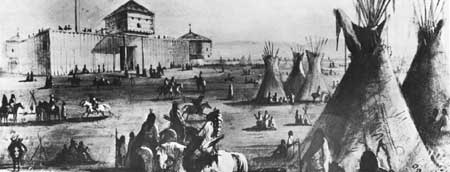|
WHITMAN MISSION National Historic Site |
 |
The Trip West
Spalding and Gray, driving the livestock overland, set out from Liberty on April 28, 1836. Whitman and the two wives waited for a steamer to take them to the assembly point of the American Fur Company caravan farther upriver. But the steamboat failed to stop, and Whitman had to hire a wagon and make a hurried pursuit of Spalding. Reunited, the missionaries caught up with the caravan near the junction of the Platte River and the Loup Fork in Nebraska on May 26.
Traveling 15 to 20 miles a day, the caravan crossed the dusty plains toward Fort Laramie. There the missionaries left the heavy wagon and, discarding excess baggage, repacked their goods on animals. They decided to take Spalding's light wagon as far as they possibly could.

Alfred Jacob Miller's painting of the first Fort
Laramie. In 1836 it was still called Fort William.
On July 4 the caravan crossed the Continental Divide at South Pass and, 2 days later, reached that year's fur-trapper rendezvous on the Green River, near Daniel, Wyo. While Narcissa enjoyed the excitement and tumult of the colorful affair, the quieter Eliza concentrated on learning the Indians' languages.
Dismayed by Parker's failure to return to the rendezvous, the missionaries were relieved by the unexpected arrival of two Hudson's Bay Company traders, John McLeod and Thomas McKay. Guided by these two experienced men, the missionaries set out on the 700-mile journey through sagebrush, desert, canyons, and mountains to the Columbia. Stopping at Nathaniel Wyeth's Fort Hall only overnight, the party moved westward along the south bank of the Snake River. The wagon finally broke down, and the men had to convert it into a two-wheeled cart. Two weeks later on August 19, they reached Fort Boise, a Hudson's Bay Company post on the Snake River.
No wagon or cart had ever come this far west before, but here Whitman and Spalding were finally forced to abandon their cart. After a few day's rest, the party moved on. Following the Powder River and crossing the beautiful Grande Ronde Valley, the missionaries reached the rugged, twisted Blue Mountains. Riding ahead to the crest, the Whitmans had their first view of the Columbia valley with majestic Mount Hood on the far horizon.
On the morning of September 1, the Whitmans excitedly galloped up to the gate of Fort Walla Walla, the Hudson's Bay Company post on the Columbia. They were met by Pierre Pambrun, the chief trader, who was to be their near and good neighbor for the next few years. Two days later the Spaldings arrived with the livestock.
Needing household goods and wanting to meet the Chief Factor, Dr. John McLoughlin, the party decided to go to the Hudson's Bay Company western headquarters at Fort Vancouver, more than 200 miles down the Columbia. Reaching the fort by boat on September 12, the missionaries completed their long journey 207 days after their departure from Angelica, N.Y. On the move for more than 6 months, and traveling more than 3,000 miles, Narcissa Whitman and Eliza Spalding had crossed the North American Continent—the first white women to do so.
|
|

|
|
Last Modified: Sat, Sep 28 2002 10:00:00 pm PDT |


